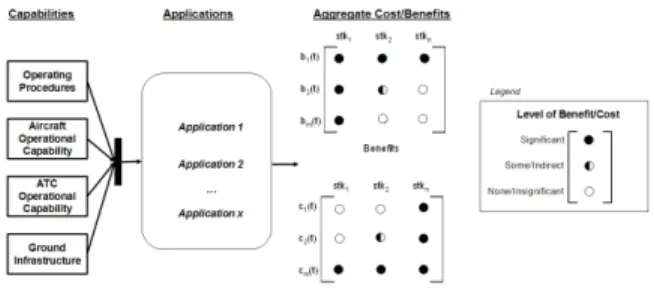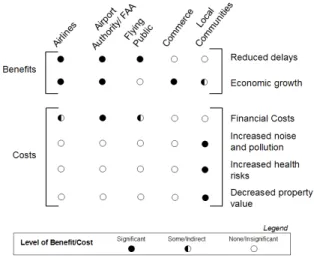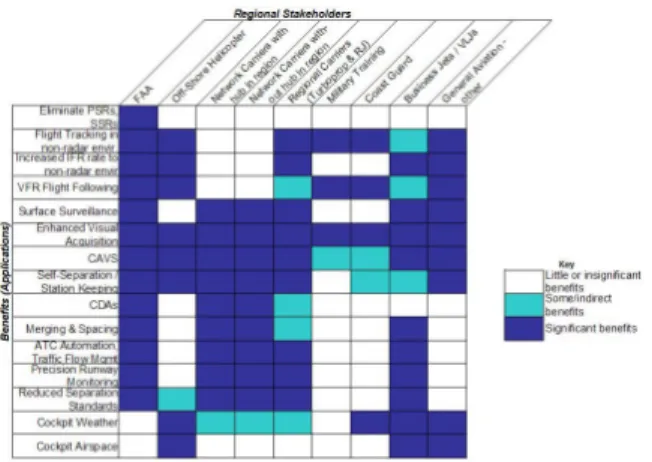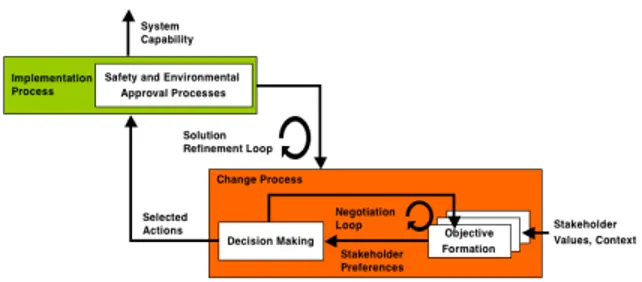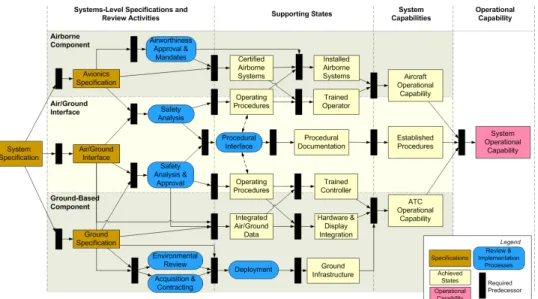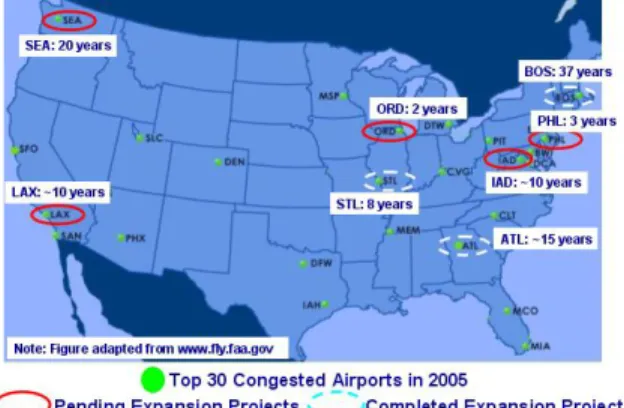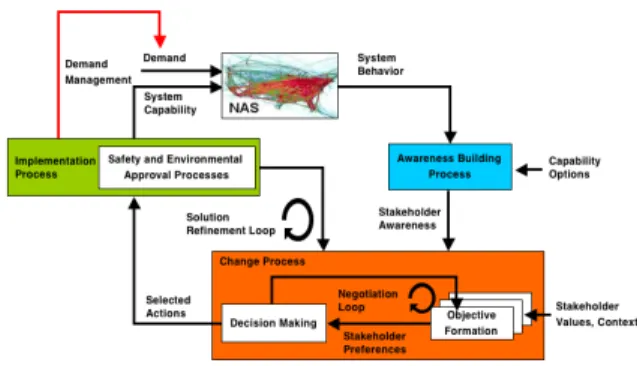THE DYNAMICS OF AIR TRANSPORTATION SYSTEM
TRANSITION
Aleksandra Mozdzanowska, Roland Weibel, Edward Lester, and R. John Hansman
Massachusetts Institute of Technology, Cambridge, MA
Abstract
Both U.S. and European Air Transportation Systems face substantial challenges in transforming to meet future demand. This paper uses a feedback model to identify and describe key issues in the dynamics of system transi-tion, with particular emphasis on stakeholder cost-benefit dynamics and processes for reviewing and implement-ing new system capabilities. Understandimplement-ing of these dy-namics is further reinforced through discussion of ADS-B and new runway construction examples. To implement the significant changes currently envisioned for ATM sys-tems, it will be critical to structure system changes to an-ticipate and overcome stakeholder disagreements and im-prove the efficiency of the approval and implementation processes.
1
Introduction
The Air Transportation Systems in both the United States and Europe are facing several substantial challenges. Limited system capacity, in the face of continuously in-creasing demand for travel, poses one of the largest chal-lenges to the continued operation of the US system. Fu-ture increases in traffic levels are projected to outstrip cur-rent capacity in several key points of the system poten-tially causing significant disruptions. In response to this anticipated demand increase and other pressures, both the U.S. Joint Planning and Development Office (JPDO) and EU SESAR (Single European Sky ATM Research) pro-grams are proposing ambitious modernization goals for their respective domestic and international ATM systems. These modernization efforts must take place while also improving system safety and security, reducing environ-mental emissions, and involving multiple stakeholders in the decision process.
The purpose of this paper is to identify and discuss the dynamics of air transportation system transition, in order to understand the barriers to change that make such tran-sitions difficult as well as the opportunities that exist to make transitions successful. Once barriers and possible
leverage points are identified and understood, problems during transition can be anticipated and strategies to miti-gate their effect can be developed. The paper details why barriers occur, where along the transition process they can be expected, how they work, and what the implications are. In addition, the paper identifies opportunities that ex-ist for addressing such barriers. Understanding and an-ticipating issues that may arise during transition is critical to achieving the required increases in system performance proposed by JPDO and SESAR to meet future demands.
Transition dynamics and barriers are discussed using a model developed based on past cases of transition. While the specific examples discussed derive from US experi-ences, the general barriers and dynamics identified are applicable both to US and European efforts to modernize Air Traffic Management. Two examples of system im-provements are used to illustrate specific aspects of sys-tem transition. The examples were chosen because they represent possible solutions for addressing capacity con-cerns. Both are also examples of currently undergoing or planned transitions in the US Air Transportation sys-tem. The first example is Automatic Dependent Surveil-lance Broadcast (ADS-B). ADS-B is an integrated set of airborne and ground components that provide the posi-tion of aircraft as a replacement or complement to radar-based surveillance. The ADS-B datalink also enables the receipt of information from other aircraft or the ground. ADS-B is the pathfinder example for technology modern-ization included in JPDO’s Next Generation Air Trans-portation System [1]. The second example discussed will be runway expansion, a crucial activity for expanding airport capacity outlined in FAA’s Operational Evolution Plan (OEP) [2].
2
Transition Model
In order to understand the barriers to transition in the air transportation system a feedback model of transition is used. The model, presented in Figure 1, was developed based on 13 cases of historical transition efforts in the US Air Transportation System. Cases studied include
tech-nology and policy changes, successful and unsuccessful changes, as well as safety and capacity driven changes. The framework provided by the model is used to study barriers caused by the multi-stakeholder nature of transi-tion as well as those posed by the complexity of the im-plementation process.
Figure 1. Transition Model
Boxes in the model represent high-level processes while arrows represent the resulting states. The Air Trans-portation System is represented as a process in the model, the output of which is system behavior. These outputs are monitored as part of the awareness building process. Dur-ing the awareness buildDur-ing process, stakeholders (a stake-holder is anyone with an interest in the outcome or in-volved in the process of a transition) develop an under-standing and definition of the problem and potential so-lutions. Each stakeholder forms their own mental model of the situation. This includes projecting future outcomes based on potential actions to address the problem.
Once stakeholder awareness of a problem and potential solutions exist, stakeholders engage in the change process. During this process, stakeholders evaluate the projections for the future and develop preferences based on the for-mation of their individual objectives. While these prefer-ences are determined separately for each stakeholder, they can be modified as stakeholders act and interact during the decision making process. The change process terminates when an action to address an issue is selected, often by the stakeholder with authoritative power.
Once an action is selected, it proceeds through the im-plementation process. In this process, stakeholders allo-cate money, refine the details of the solution, and approve the chosen solutions. Once implementation is complete and successful, the capability of the system is improved and the problem being addressed is reduced or eliminated. However, barriers to change can arise in multiple places in the model and stall or even derail change efforts. In partic-ular, the multi-stakeholder nature of the change process as well as the complexities of implementation can pose
bar-riers to change. These barbar-riers are captured in the nego-tiation and solution refinement loops shown in the model and discussed below.
The negotiation loop occurs during the change process and captures the dynamics of decision selection in a situ-ation with multiple stakeholders who have different agen-das, value structures, and are effected differently by po-tential changes to the system. During this process stake-holders work to influence decision makers and interact with others to determine if concessions and agreements can be reached. Inability to overcome strong stakeholder oppositions can contribute to long transition time con-stants.
Barriers can also arise during the implementation pro-cess. The complexities of determining the specifics of a solution as well as conducting the necessary safety, environmental, and other approval processes can delay change. In addition, stakeholder disputes can once again arise when details of a solution are being determined. Fi-nally, the approval processes that occur during implemen-tation can be deliberately used by stakeholders who are negatively affected by a change but were unable to influ-ence decision makers against its implementation.
Several key issues which arise during system transition will be discussed in the context of the model in the fol-lowing sections.
3
Stakeholder Objectives and
Deci-sion Making
3.1
Stakeholder Cost-Benefit Dynamics
The distribution of costs and benefits can have a signifi-cant impact on the stakeholder dynamics during the pro-cess of transition. Understanding and anticipating stake-holder dynamics by analyzing the distribution of costs and benefits to stakeholders is an important aspect of achiev-ing successful transitions. Marais and Weigel [3] provide a framework for discussing cost-benefit dynamics through the utilization of cost-benefit matrices. This framework can be expanded, as shown in Figure 2, to illustrate that the distribution of costs and benefits is influenced by the applications that stem from a proposed capability change in the system.
As shown in the figure, a new system capability can be decomposed into operating procedures, aircraft oper-ational capability (i.e. equipage), ATC operoper-ational capa-bility, and ground infrastructure changes. These capabil-ities then enable new applications from which stakehold-ers derive benefits. The new capabilities also need to be
Figure 2. Transitioning from Capabilities to Benefits
financed. As a result, the benefits that can be achieved come at a cost.
3.2
Decision Making
When an opportunity or need for system transition exists, stakeholders determine their objectives based on how they will be affected by different possible actions. Such value analysis may be determined by a rigorous analysis of costs and benefits or can be merely perceived by a stakeholder. These objectives determine what a stakeholder wants to accomplish during the change process shown in Figure 3.
Figure 3. Stakeholder Negotiation Loop Engaging in the change process requires interaction and negotiation between stakeholders to make a decision and select an action. The ability of stakeholders to arrive suc-cessfully at a decision depends not only on how much disparity exists between the objectives of different stake-holders, but also the relative power of each stakeholder in influencing decision making. The process of transi-tion can stall at any point during the negotiatransi-tion loop, be-cause stakeholders are unable to resolve their differences on problem understanding, the correct action to address the problem, or the details of how a selected action should be implemented. However, successful transition can be facilitated through incentives or other measures that better distribute stakeholder benefits and costs. These measures can be used during the negotiation loop to help accelerate the change process and foster acceptance of a solution.
Stakeholder dynamics can also change throughout the transition process. For example, the level of system equipage can change the cost benefit structure for
stake-holders still deciding whether or not to equip. In addi-tion, shocks to the system can cause stakeholder changes in cost-benefit evaluations and in relative power. Major accidents can highlight an underlying system deficiency and generate sufficient public pressure to change. Many safety technologies, such as TCAS and EGPWS, were im-plemented to address problems highlighted by such acci-dents.
In the following sections, the distribution of costs and benefits as well as how that distribution influenced stake-holder dynamics during the change process are discussed for three example cases. Aggregate costs and benefits of potential applications are discussed for the Capstone ADS-B project and for runway expansion at Boston Lo-gan International Airport, while detailed benefits by ap-plication are discussed for ADS-B implementation in the Gulf of Mexico.
3.3
Asymmetrical Cost and Benefit
Distribu-tion: The Case of Runway Construction
An example where differences in stakeholder preferences impede change is in airport expansion. Many airports are currently facing capacity constraints as well as increasing demand, resulting in increased delays. As part of the FAA Operational Evaluation Plan a number of these airports are attempting to expand runway capacity by extending or adding runways. However in many cases these projects have been met with strong community opposition.
Applying the framework presented in Section 3.1, de-creasing airport delays by inde-creasing capacity would be the new capability added by the transition. The applica-tion that achieves this capability is a new runway or ex-tended runway. The distribution of benefits and costs be-tween different stakeholders are shown in Figure 4.
Relevant stakeholders include the airlines which oper-ate at an airport in question, the local airport authority, the flying public (specifically those who use the airport), com-merce groups, local communities living around the air-port and the groups representing them, local government, and the FAA. The local government is not included in the cost-benefit matrix because it is not directly impacted by the construction of the runway, but acts indirectly in the process. Local governments are lobbied by local commu-nities, commerce groups, as well as port authorities and airport users. They are also elected by members of all or some of these groups and have a responsibility to repre-sent their interests.
The reason for community opposition is apparent from the cost-benefit distributions shown in Figure 4. Com-munities perceive themselves as paying most of the non
Figure 4. Perceived Aggregate Cost Benefit Matrices for Airport Runway Expansion Projects
financial costs of the runway, such as increased noise and pollution, while the benefits extend mostly to other groups. Benefits to communities that result from airport expansion are less clear. Strong air transportation is tied to the economic health of regions and can induce economic growth and development, but the effects are difficult to measure and therefore are not apparent to communities as a tangible benefit.
There have been successful cases of airport expansion projects. In these cases the communities are often more removed from the airport. In addition, interested par-ties anticipate potential stakeholder opposition and mit-igate the adverse effects to communities. In success-ful examples, such as projects in Atlanta or St Louis, the addition of a new runway can take about 10 years. However, there are also cases such as Boston and Seattle where community opposition is very difficult to overcome and expansion projects can stall for as much as 30 years even when mitigation measures such as sound proofing are implemented and compromises on runway usage are made [4, 5].
3.4
The Role of Incentives: ADS-B Capstone
Project
The Alaska Capstone project was an early demonstration program for ADS-B capabilities, and today continues as part of the current plans to implement ADS-B through-out the NAS. Several factors make Alaska an ideal loca-tion for demonstraloca-tion projects, and ADS-B in particu-lar. These factors include a lack of surveillance coverage in some areas, remote and inhospitable terrain, and harsh
weather conditions [6]. Potential safety improvements, combined with strong political support provided an oppor-tunity to deploy and certify prototype ADS-B capabilities early in the development lifecycle through the Capstone project.
During Capstone, aircraft were voluntarily equipped with an IFR certified GPS receiver, Multifunction Dis-play, and associated ADS-B data-link and avionics, with reimbursement from the FAA. At the same time, the FAA worked with avionics manufacturers to support tech-nological implementation of ADS-B avionics, deployed ground-based transceivers (GBTs), and integrated ADS-B reports into the air traffic control system. Specific ca-pabilities provided in Capstone included the broadcast of aircraft position to ATC, up-linked traffic, weather, and aeronautical information (e.g. NOTAMs). The applica-tions provided included surveillance outside of existing radar coverage and increased onboard situation aware-ness [7]. The aggregate benefits provided by these ap-plications compared to the costs incurred are shown in Figure 5. As a demonstration program, equipage was in-centivized by the FAA who covered costs that would have normally been borne by operators and avionics manufac-turers. As a result, benefits were provided at little per-ceived cost to the aircraft operators.
Figure 5. Aggregate Cost Benefit Matrices for the Cap-stone Project in Alaska
The Capstone project in Alaska presented a case where stakeholder alignment was achieved with the use of incen-tives. Another effect of this alignment was a rapidly accel-erated timetable for certification, procedure development, and deployment of ADS-B capability. Capstone com-ponents and procedures were certified and implemented
rapidly, from initial definition and funding in 1999 to op-erational capability in 2001 [7].
3.5
Temporal Evolution of Costs and Benefits:
ADS-B Deployment in the Gulf of Mexico
In some cases, costs and benefits of a set of enabled ap-plications can change as the transition progresses, usually through varying levels of equipage. The FAA is intro-ducing ADS-B, GBTs, and services regionally, with the Gulf of Mexico as one of the first locations. Deployment in the Gulf of Mexico provides immediate benefits to op-erators and the FAA due to the lack of radar coverage, and an opportunity to place ground stations on oil plat-forms already located in the Gulf [8]. Investigating the planned deployment of ASD-B in the Gulf of Mexico pro-vides a notional illustration of how benefit distributions can change substantially with the rate of user equipage. Matrices of application-level benefits by stakeholder for ADS-B implementation in the Gulf region are presented in Figures 6 and 7 for an assumed 1/3 (partial) equipage state and full equipage respectively.
Figure 6. Application Benefits Matrix for Gulf of Mex-ico (1/3 Equipage)
Figure 6 shows benefit levels to operators and the FAA who are early adopters, assuming approximately 1/3 of to-tal flights are ADS-B out equipped, but full ground infras-tructure capability is present. These early adopters pri-marily receive benefits when they comprise a large frac-tion of the flights into and out of an airport (network carri-ers with hub in region) or when applications are provided proportional to fleet equipage (e.g. enhanced visual ac-quisition, cockpit weather, fleet tracking). Specific to the Gulf of Mexico, off-shore helicopter operators would ini-tially benefit from fleet tracking and radar-like IFR sep-aration applications. All operators could initially benefit from enhanced visual acquisition of traffic, leading to
in-Figure 7. Application Benefits Matrix for Gulf of Mex-ico (Full Equipage)
creased safety and possibly increased capacity in VFR and MVFR conditions.
Figure 7 depicts the benefits to operators and the FAA after full ground station implementation and operator equipage. Most benefits are provided to all operators and are realized since the critical mass has been met and all ADS-B applications can be performed. The FAA realizes few benefits are available until the critical mass is reached and current procedural separation standards can be re-placed with increased capacity through radar-like separa-tion services. Because benefits to stakeholders increase significantly as more operators equip, this example illus-trates a strong case for using of incentives to accelerate fleet equipage and gain full benefits as rapidly as possi-ble.
4
Complexities of the
Implementa-tion Process
Once an action has been selected during the change pro-cess, it needs to be implemented. The selected action is often a broad commitment to a new technology or imple-mented system and many steps still need to take place be-fore implementation is complete. The complexities of the safety and approval process, while necessary, can intro-duce substantial delays into the transition process by ini-tiating the solution refinement loop shown in Figure 8. A critical aspect of achieving system transitions envisioned in NGATS and SESAR will be the ability to obtain safety and environmental approval for new capabilities. In par-ticular, safety certification and approval poses a signifi-cant risk in system transition. A high level abstraction of the approval steps required for various aspects of system capabilities is shown in Figure 9.
Figure 8. Solution Refinement Process
4.1
Safety Review Processes
Once an overall concept of action exists, detailed plans have to be made and carried out in the implementation process. In fulfilling their commitment to public safety, national regulatory authorities must ensure that the pro-posed ATM system change can be accomplished at an ac-ceptable level of safety. To provide this assurance, the safety authorities carry out a variety of oversight functions focused on several aspects of the proposed change. Fig-ure 9 shows a simplified version of the approval process that occurs during implementation.
An improvement in the operating performance of the system can be decomposed as four basic areas: aircraft operational capability, ground infrastructure, air traffic control capability, and established operating procedures. As an example, achieving ADS-B-based separation proce-dures requires several supporting system capabilities: air-borne equipage to enable ADS-B out, ADS-B ground sta-tions to collect and rebroadcast ADS-B data and transmit to ATC, air traffic control capability to receive and display ADS-B traffic data, and defined separation procedures us-ing ADS-B data are all necessary. The characteristics of each of these components are defined by the system spec-ification and definition and each separate component and their interactions must be certified by the regulatory au-thority as meeting safety requirements.
The changes envisioned by JPDO and SESAR for sys-tem capabilities are broad in scope and involve changes in multiple areas of the system, including avionics, ground infrastructure, and the air/ground interface of data inte-gration and operational procedures. To manage complex-ities in the scope of change, regulatory authorcomplex-ities carry out a variety of oversight functions based on a decompo-sition of the system. Figure 9 shows the processes and states broken down in this manner, with the ultimate goal of achieving desired system capabilities in three basic ar-eas: aircraft operational capabilities, air traffic control op-erational capability, and established procedures.
In order to carry out the certification process, resources must be allocated to be spent on analysis in different ar-eas of the system. Within the FAA, the Air Traffic Or-ganization is responsible for the performance of the air traffic control system, while the Aviation Safety organi-zation evaluates aircraft certification and changes to flight and operating rules. In the safety analysis process, tech-nical expertise is also often required from air traffic con-trollers, aircraft operators, and other users of the system. This review process can often take a substantial amount of resources and effort and require numerous iterations of system capabilities and requirements. A large amount of analysis may be necessary in order to sufficiently prove that a system meets required safety performance, and in many cases limited operational implementations are used to understand safety consequences.
The two previous ADS-B examples discussed in this paper showed stakeholder cost-benefit dynamics in lim-ited deployment of ADS-B technology. Each implemen-tation is also an example of the opportunity to identify and understand potential operational safety issues from experience. The Capstone program initiated the technical definition of ADS-B and related service delivery archi-tecture. Because of its status as a demonstration program, and other accelerating factors, the system approval, avion-ics development, and implementation proceeded rapidly. Safety review processes were begun in 1999 and opera-tions with ADS-B commenced in Alaska in 2001 [7].
Early deployments provide an opportunity to gather data on the efficacy of the system, to mature technology, and to understand safety risks that were not anticipated in earlier review and analysis. This approach manages the complexity of implementation by controlling conditions in a limited environment and involving fewer stakehold-ers in the decision-making process. Similarly, the deploy-ment of ADS-B in the Gulf of Mexico will provide an op-portunity to attempt implementation at a smaller scale and learn about possible issues that may arise during a larger scale deployment. However, before ADS-B benefits can be fully realized, there is a significant amount of anal-ysis that must still be performed to ensure safety under the conditions of system-wide implementation. Some of this analysis is likely to duplicate effort already performed in evaluating the previous implementations. Transfer of knowledge is crucial to eliminating such inefficiencies and improving the implementation process.
The broad scope of change also requires significant co-ordination across responsibilities within the regulatory au-thority, which can require substantial resource investment. Eliminating delays and improving efficiency is important both to keep up with the rapid pace of technology
devel-Figure 9. Highly Simplified Approval Processes Necessary for Improved Operational Capabilities
opment and to certify the large number of new operat-ing capabilities required to increase capacity. This will enable the implementation process to flow efficiently, so that value can be delivered to multiple stakeholders in the NAS.
4.2
The Environmental Review Process
In addition to the safety review process, the environmental review process is necessary for runway and other infras-tructure projects. This process exists in order to ensure that projects do not pose too large a threat to the health of surrounding communities and the global environment. For any runway project, the environmental review pro-cess takes place once the preliminary design is complete. This includes the layout, costs, benefits, and possible al-ternatives for the project. The first step of this process is to conduct an environmental assessment to determine if the project will have significant impact on noise, air quality, water quality, or historical artifacts. If the answer is no, and all state regulations have been met, a project can proceed to acquire permits and than begin construc-tion. However, if significant impacts are expected an En-vironmental Impact Statement (EIS) must be prepared. A notice of intent is first required, followed by a draft EIS which is reviewed by interested stakeholders including the public. Incorporating comments from the review process, a final EIS is prepared and submitted for review. If the statement is approved a record of decision is issued and the project can proceed to permitting and construction [9]. The environmental review process can take several years including time to prepare, review, and approve the
environmental impact statement. This can add a signifi-cant amount of time to the overall transition process. In addition, the EIS is often used by those opposing a runway project as the object of litigation thereby further delaying construction.
A study conducted by the General Accounting Office surveyed the top 50 airports in the US. 92% of study participants said that it was more difficult to balance en-vionmental concerns with airport operations than it was in 1989. Noise was listed as the largest concern by 58% of participants, followed by water quality listed by 24% of participants, and local land and air issues listed by 16%. 88% of the participats stated that the environmental re-view process contributed to delaying runway projects and 72% said that it was the primary cause of delay. The me-dian time for an airport project amount the participating airports was 10 years [10].
The FAA Operational Evaluation Plan (OEP) is a plan to expand existing airports. Figure 10 shows the airports with recent and current OEP projects as compared to the top 30 most congested airports in the country. The figure shows that only a small fraction of the airports that are congested are attempting to expand capacity. This indi-cates that more construction projects will be needed in the future as demand continues to increase. However, with lengthy construction times these projects may not be re-alized in time to accommodate the growth rate. The fig-ure includes both pending and completed projects and the number of years since initiation. It can be seen that run-way projects can take about 10 years to complete in the best case and almost 30 years in the worst case.
Figure 10. OEP Airport Projects
One way to help resolve stakeholder issues is to make redesigning projects easier. Currently, the environmental review process can pose a barrier to resolving stakeholder conflicts when redesigning a construction project would mean that the environmental approval process would have to be redone, causing a delay. Methods for revising and iterating on the design of runway projects, while main-taining the validity of the environmental impact statement, could be developed to make the process more efficient.
4.3
Stakeholder Differences during
Implemen-tation
During the implementation process, stakeholder issues re-main important to the dynamics of change. Although stakeholders may have agreed to an overall plan of action, they also need to agree to the details of implementation and their roles in it. Implementation requires making de-tailed plans and schedules: technical issues need to be re-solved, stakeholders need to agree on budgets and the dis-tribution of costs, as well as timetables for development, testing and implementation. Each of these actions can act as a barrier to forward progress delaying or stalling the transition process. The issues dealing with stakeholder differences during the implementation process are cap-tured in the refinement loop in Figure 8, which can be-come a delay loop in the transition process.
In the case of ADS-B, stakeholder differences have impacted the architecture of the broadcast communica-tion standard. Three candidate technologies were ini-tially considered to provide transmission and reception of ADS data: Voice Data Link Mode 4 (VDL Mode-4), 1090 Extended Squitter (1090ES), and the Universal Ac-cess Transceiver (UAT). After a cost-benefit analysis [11], VDL Mode 4 was ruled out in cost and benefits, UAT was shown to be less expensive for GA operations and offer a higher bandwidth for uplink of graphical weather
infor-mation, and 1090ES was shown to be roughly equivalent in performance but would be less expensive for air carriers because they are already equipped with 1090-Mhz capa-ble Mode S transponder. The final decision in the US was to support ADS-B through both protocols. The decision to support both protocols required the addition of a “Mul-tiLink Gateway” to all ground stations so that UAT traffic information is uplinked to 1090ES equipped aircraft and 1090ES traffic information is uplinked to UAT equipped aircraft, eliminating the ability to perform air to air sepa-ration applications without working ground stations. The consequence of this decision is shown in Figure 11, in-dicating the uncertainty in link equipage applicability for medium-sized aircraft.
Figure 11. ADS-B Communication Standards [12]
In addition to choosing the link technology, choos-ing a standard protocol on that link has been problem-atic for stakeholders. The initial ADS-B system perfor-mance standards (MASPS) were developed by RTCA as DO-242. However, limitations and issues with this pro-tocol were discovered. In particular, the way in which GPS integrity and accuracy is characterized proved to be an issue [13]. This led to DO-242A, a newer protocol that resolves many of the problems found with the original standard. However, avionics manufactures and operators have been hesitant to implement the DO-242A standard in equipment because of uncertainty in which standard the FAA will support, or if stakeholders will revise the ADS-B MASPS again in the future.
In addition to agreeing on the technical details of a solu-tion, it is also necessary that individual stakeholders com-mit to fulfilling their part of the implementation plan. For example, carriers may be required to equip aircraft with a specific technology. They can be reluctant to do so if such equipage is not perceived as being in their benefit. In addition, stakeholder may not want to commit to pay-ing and carrypay-ing out their share if the benefits they are expecting also depend that another party do the same. There have been past examples where the FAA required airlines to equip their aircraft but never delivered the
in-frastructure to make the equipage beneficial or even use-ful leading to mistrust. Commercial airlines mistrust the FAA’s ability to deliver infrastructure following the fail-ure of CPDLC, and general aviation has similar concerns following the FAA’s decision to not mandate the Mode-S transponder. These past examples are leading carriers to question whether or not the FAA will deliver the neces-sary infrastructure, and if it does so whether or not carriers will truly see a benefit or if the FAA will be the only one to see a drop in costs.
One way to get past stakeholder hesitancy is to once again use incentives to equip or carry out whatever neces-sary actions. Incentives can change the cost benefit struc-ture for a stakeholder and as a result change their objec-tives making the decision to act more in their benefit. Mit-igation measures can also be used to help offset the effect of costs which may disproportionately affect a subset of stakeholders.
Mandates can also be used to move past stakeholder barriers. This can be an effective means of bringing about change when a stakeholder with the authority to mandate a change exists. A mandate can clarify the details of a transition and as a result eliminate uncertainty from the cost-benefit analysis carried out by stakeholders. Elimi-nating such uncertainty and clarifying benefits can make stakeholders more willing to equip. However, in order for a mandate to be successful, stakeholders have to trust that the mandating party will fulfill their part of the transition.
4.4
Deliberate Blocking of Transition
Even with the use of mitigation, not all stakeholders can be convinced to accept a change. Those stakeholders that feel they would lose significantly by the implementation of a proposed change have a large stake in continuing a fight even when a decision has been agreed on by others. Stakeholders most likely to try to block implementation are those who were marginalized or not represented at the original decision process or those who believe that the se-lected solution is so negative to them that the status quo is preferable to the change. Such stakeholders also usually do not have the ability to unilaterally change the decision. As a result, their objective becomes to get in the way of implementation in the hopes of preventing implementa-tion or maybe restarting negotiaimplementa-tions.
Stakeholders can build support and coalitions, in some cases attempting to involve the public or lawmakers. This can increase the power asserted in favor of a particular so-lution or even any soso-lution. To do this, they need to frame the argument in a way that gets the attention of others. A standard framing tactic is the use of established values that others will resonate with. In the policy arena
com-mon values used to fame disputes are equity, efficiency, security, liberty, and community [14]. In the air trans-portation system a powerful value is safety. Maintaining and promoting safety has been one of the main goals of the system since its inception and many past changes oc-curred because of safety drivers. In particular, accidents provide a powerful catalyzing event for change. They cre-ate widespread awareness and engage the general public who in turn engage legislators. Because it is such a strong value, it can also be used to block change. All a stake-holder needs to do is to successfully create doubts about a proposed change’s safety and that change will be delayed or even canceled.
The Capstone project provides an example where the “safety veto” was used twice. In March 2006, ADS-B returns were removed from controllers’ display screens in the Anchorage center due to controller concerns about discriminating between aircraft radar returns and ADS-B equipped returns [15]. The Alaska Aviation Coordina-tion Council, a group that represents commercial opera-tors in the area, was concerned with the safety implica-tions of lack of ADS-B data for controllers. Based on these concerns, the FAA evaluated ADS-B to radar proce-dures and returned ADS-B returns to controllers’ scopes in May [15]. In this case, safety was used as an argument both to oppose the specific use of ADS-B procedures and then to reinstate them.
Another tactic for preventing or stalling change is to argue about the validity of data, models, or predictions. Discrediting the basis of the understanding of the prob-lem as well as the basis for evaluating the effects of solu-tions can stall the process or send it back to earlier stages. This technique was used in the fight over the construction of runway 14/32 at Logan airport in Boston: the runway opened on Thanksgiving Day in 2006, but a series of liti-gation between the local port authority and affected com-munities delayed the project for 30 years [4]. The fights focused in no small part around the assumptions made in predicting the effects that the runway would have on local communities.
Unfortunately, models and especially predictions al-ways contain assumptions which can be attacked. Issues of credible knowledge assessment becomes a powerful tool in policy disputes. It raises the question of how ac-curate models have to be, and also who has the credibility use them and be believed.
When stakeholder differences become entrenched, and a marginalized stakeholder cannot be pacified with mit-igation, stagnation of a transition can occur. As a result, the time to bring a change about can increase significantly.
5
Implications of Long
Implementa-tion Time
Long implementation times can have the consequence of rendering transition efforts irrelevant. The rapid pace of technology development means that the next generation solution could be developed and available before the ex-isting solution can be implemented in the NAS. This may force stakeholders to decide to abandon an existing sys-tem and try to begin again with the new technology. The problem with such a strategy is that it can occur repeatedly as technology development progresses and the transition process is restarted with each new development.
An example of the effect of technological improve-ments relates to the ADS-B dual link decision. Since the 2001 dual link decision in the US, rapid evolution in tech-nology has undercut the assumptions in the dual-link de-cision. 1090ES equipment can be manufactured and in-stalled in small aircraft at a similar cost and size as UAT equipment. Also, in-cockpit satellite-based weather ser-vices have grown rapidly in the general aviation indus-try, providing an alternative to the weather products pro-vided by UAT. As a response to technological improve-ments, a contractor has proposed a single 1090ES system supplemented with commercial satellite-based in-cockpit weather. This has the potential to eliminate the complex-ity of multilink gateways in the ground infrastructure [16], but would require revisiting approval processes.
Long implementation times can also mean that prob-lems become moot before they are addressed because the environment has changed or stakeholders have adapted in a number of other small ways. Examples include the Mi-crowave Landing System (MLS) and expansion projects in Saint Louis (STL) where expected demand did not ma-terialize citestl. While this can be beneficial because a problem has been solved, it may be that small local solu-tion have been put in place and are inefficient for the sys-tem as a whole. Even in cases where the adaptations have proved to be successful and efficient, a transition process may not be halted just because the problem no longer ex-ists. In these cases, money will still be spend on the orig-inal attempted solution.
In the case of runway and infrastructure expansion long implementation times mean that capacity increases are not made in time to support demand. In such a case, manag-ing demand will be the only option available which can be implemented rapidly. Figure 12 shows how demand man-agement would modify the demand input into the system transition model. Demand management is already in place at 4 slot restricted airports in the US. In these cases slot re-strictions were implemented as emergency measures and
have remained in place. Recently political pressure re-sulted in an attempt to remove restrictions at two of the airports, but without success. As are result of slot re-moval in 2000, LaGuradia suffered crippling delays and slots had to be reinstated [17]. Currently, plans for how to best distribute the limited resources at these airports in an efficient and equitable manner are still being made.
Figure 12. Demand Management
6
Conclusions
A critical enabler to bringing about the next generation air transportation system in the US and in Europe is the ability to strategically and effectively transition the air transportation system. Stakeholder opposition to change as well as the complexities of the implementation process both pose significant barriers to change. Effective means of using incentives and mitigation need to be developed in order to move past stakeholder barriers. In addition, it is critical that efficient safety and environmental review processes be developed in order to faster implement new capabilities into the air transportation system.
Biographies
Aleksandra Mozdzanowska received her undergraduate degrees in Aeronautics and Astronautics and in Literature, from MIT in 2002. She completed her Master’s degree at the MIT International Center for Air Transportation in 2004. Her thesis focused on the impact of regional jet growth on the national airspace system. She is currently a PhD student in the Technology Management and Policy program in the Engineering Systems Devision at MIT. Her research focuses on understanding the transition dynam-ics in the air transportation industry. She can be reached at: 17-110 MIT, Cambridge, MA 02139, 671-253-2428, email: alexm@mit.edu
Roland Weibel received his undergraduate degree in Aerospace Engineering, from the University of Kansas in
2002. He received his S.M. degree from MIT in 2005. His thesis focused on the integration of unmanned areal vehicles into the national airspace system. He is currently a PhD student in the Aeronautics and Astronautics De-partment at MIT where his research focuses on improving safety and approval processes for new operational capa-bilities in air transportation. He can be reached at: 17-110 MIT, Cambridge, MA 02139, 671-253-2428, email: weibel@mit.edu
Edward (Ted) Lester received a B.A. in Physics from Middlebury College in Vermont in 2005. He is cur-rently working on his S.M. in Aeronautics and Astronau-tics at MIT. His S.M. thesis is on incentives for ADS-B implementation in the US National Airspace System. Ted also works as a systems engineer at Avidyne Cor-poration working with general aviation cockpit displays. He can be reached at: Avidyne Corporation, 55 Old Bedford Rd, Lincoln, MA 01773, 781-402-7464, email: elester@avidyne.com.
R. John Hansman has been on the faculty of the Depart-ment of Aeronautics and Astronautics at MIT since 1982. He obtained his A.B. in Physics from Cornell University in 1976, his S.M. in Physics in 1980 and his Ph.D. in Physics, Meteorology, Aeronautics and Astronautics and Electrical Engineering from MIT in 1982. He is the Di-rector of the MIT International Center for Air Transporta-tion. His current research activities focus on advanced information systems and complex system issues in the operational domains of air traffic control, airline opera-tions and aircraft cockpits. He can be reached at: 33-303 MIT, Cambridge, MA 02139, 671-253-2271, email: rjhans@mit.edu
Key words
cost-benefit, system transition, stakeholder, ADS-B, run-way expansion, air transportation
References
[1] 2005 progress report to the next generation air trans-portation system integrated plan. Technical re-port, Joint Planning and Development Office, March 2006. Last accessed 3 January 2007.
[2] Operational evolution plan version 8.0. http://www. faa.gov/programs/oep/, 2006. Last accessed 24 Jan-uary 2007.
[3] Karen Marais and Annalisa L. Weigel. Encourag-ing and ensurEncourag-ing successful technology transition in civil aviation. MIT Engineering Systems Division
Working Paper Series, March 2006. Last accessed 15 December 2006.
[4] Peter J. Howe. The 30-year saga of 14/32. The Boston Globe, November 19 2006.
[5] Martin McOmber. Our billion-dollar runway: Who will pay? The Seattle Times, July 4 2004.
[6] J. Call and J. Hallinan. Industry and FAA test new technologies in Alaska. In Digital Avionics Systems, volume 2, pages 6D1/1–6D1/9, Daytona Beach, FL, October 2001.
[7] Capstone program plan draft version 3.0. Technical report, Federal Aviation Administration, June 2001. Last accessed 3 January 2007.
[8] Bobby Nichols. Surveillance and broadcast services program overview. http://www.adsb.gov/briefing_ nwchapter.htm, October 2006. Presentation to Northwest Chapter of the American Association of Airport Executives (NWAAAE).
[9] Aviation infrastrucutre: Challenges related to build-ing runways and actions to address them. Techni-cal Report GAO-03-164, United States General Ac-counting Office, January 2003.
[10] Aviation and the environment: Results from a sur-vey of the nation’s 50 busiest commercial service airports. Technical Report GAO/RCED-00-222, United States General Accounting Office, August 2000.
[11] John Scardina. Overview of the ADS-B link deci-sion. Technical report, Federal Aviation Adminis-tration, June 2002.
[12] John Scardina. The approach and basis for the FAA ADS-B link decision. Technical report, Federal Avi-ation AdministrAvi-ation, June 2002.
[13] White paper: Proposed revisions to ads-b masps: In-tegrity and accuracy monitoring. Technical Report 242A-WP-6-23A, RTCA, Inc SC-186 Work Group 6, 2001.
[14] Deborah Stone. Policy Paradox: The Art of Political Decision Making. W.W. Norton & Company, 2002. [15] Adrian Gerold. ADS-B launch: Performance-based
strategy. Avionics, 30(7), July 2006.
[16] Brian Evans. A single solution to ADS-B? Avionics, 29(5), May 2007.
[17] Hearing on air traffic congestion in the new york city area. http://www.house.gov/transportation/aviation/ 07-16-01/07-16-01memo.html. Last accessed 11 October 2006.

